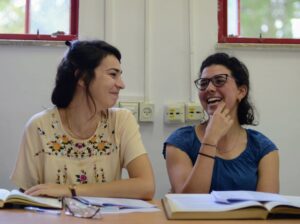Hadar Institute – Strategic Planning During a Pandemic
January 15th, 2021
As the Hadar Institute rapidly responded to offer new digital Jewish learning and engagement in 2020, behind the scenes it was conducting a major strategic planning process. Always an important undertaking, developing a strategic plan during a pandemic was both uniquely challenging and one that offered unexpected opportunities. While the pandemic presented unprecedented obstacles, the strategic planning process provided a sense of grounding and the ability to look toward the future in an otherwise difficult time.
The future Hadar envisions is not limited by the current reality. But Hadar took learnings from experiments during the pandemic and incorporated those into their plan. Hadar’s leadership tried new ways of learning they never would have imagined possible before, such as digital education offerings on such a large scale, and new formats for learning, such as digital cohorts.
 For example, the ubiquity of online learning in 2020 enabled Hadar to broaden its understanding of who they might teach beyond young adults. In a two-month period of online learning, Hadar taught as many people as it typically teaches in person over an 8 month period. More than 40 percent of those people were new users to Hadar. This expanded reach continued beyond the first few months of the pandemic: Hadar welcomed 30,000 participants to more than 800 class sessions since March. Thus, Hadar recognized that online learning had to become a mainstay and an integrated part of their plan.
For example, the ubiquity of online learning in 2020 enabled Hadar to broaden its understanding of who they might teach beyond young adults. In a two-month period of online learning, Hadar taught as many people as it typically teaches in person over an 8 month period. More than 40 percent of those people were new users to Hadar. This expanded reach continued beyond the first few months of the pandemic: Hadar welcomed 30,000 participants to more than 800 class sessions since March. Thus, Hadar recognized that online learning had to become a mainstay and an integrated part of their plan.
Project Zug [Hadar’s online 1-1 learning platform] offers an easy on-ramp to making Torah learning a regular practice in people’s lives. It has certainly become part of my life! – 2020 Project Zug Participant
During the pandemic, Hadar also capitalized on years of investment in the children and families space through Pedagogy of Partnership (PoP), among other initiatives, to run new experimental learning opportunities for this demographic. Hadar’s Mishnah club began in mid-March and a grandparents and grandchildren learning event later in the year enabled Hadar to reach children and parents directly. These innovations and others were so successful that Hadar launched a new Children’s and Families Department. The strategic planning process underway as these experiments occurred enabled Hadar to concretize its vision for this department moving forward.
Hadar was my introduction to Jewish life and thought. It was the first place I had role models for how to live a deeply committed, gender-egalitarian life, and has helped me to develop a deep identification with the Jewish tradition. – Yeshivat Hadar Alum
Along with these learnings, the organization’s growth from the first strategic plan led to mergers and acquisitions of different programs— including the Maimonides Moot Court Competition, the JJ Greenberg Institute, Project Zug and Pedagogy of Partnership—that help chart an ambitious and exciting path forward. This path encompasses five goals over the next four years, which Hadar details in its plan:
including the Maimonides Moot Court Competition, the JJ Greenberg Institute, Project Zug and Pedagogy of Partnership—that help chart an ambitious and exciting path forward. This path encompasses five goals over the next four years, which Hadar details in its plan:
View Hadar Institute’s Strategic Plan at Hadar.org/plan. The Jim Joseph Foundation is a supporter of Hadar.